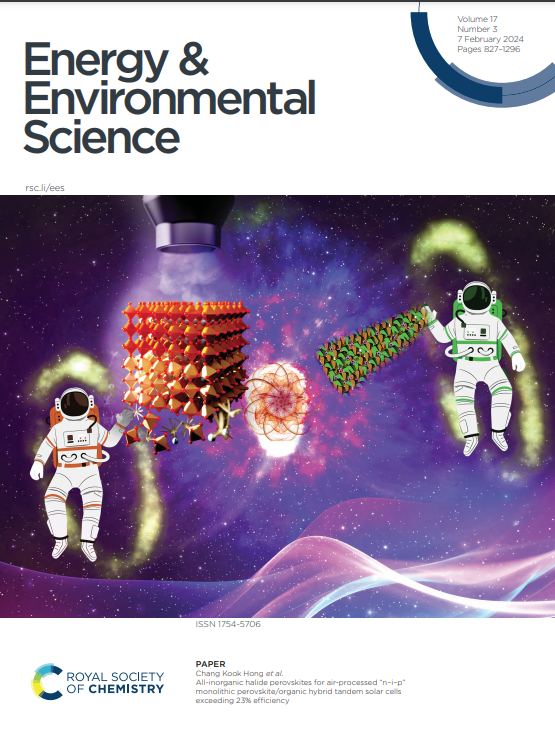阴离子交换膜水电解槽Ni/CeOx界面高效析氢
IF 32.4
1区 材料科学
Q1 CHEMISTRY, MULTIDISCIPLINARY
引用次数: 0
摘要
采用动态氢泡模板(DHBT)方法设计了具有Ni/CeOx界面的宏/介孔膜,用于阴离子交换膜水电解槽(AEMWEs)的安培级制氢。AEMWE实现了95%和80%的领先能源效率,分别基于氢气的高热值和低热值,分别为0.25 A cm - 2,产生42 kW h kg - 1的氢气,成本为0.84美元/ kg,从而达到了美国能源部(DOE) 2030年的价格目标(1美元/ kg)。在AEMWE中,在2.08 V和60°C条件下实现了5 A cm−2的电流密度,整体细胞激活和浓度过电位为594 mV,在该领域处于领先地位。Ni/CeOx催化剂表现出优异的析氢反应(HER)活性,在20°C下,在201 mV的过电位下提供1 A cm−2,远远超过Ni, CeOx和基准Pt/C催化剂。电化学和理论计算表明,在析氢过程中,中间体在定制缺陷界面上的优先吸附加速了电荷转移。在电沉积过程中,氢在AEMWE中形成3D通道,用于去除气泡,类似于氢存储器,加速了传质。本文章由计算机程序翻译,如有差异,请以英文原文为准。

Efficient hydrogen evolution at Ni/CeOx interfaces in anion-exchange membrane water electrolysers
A macro/mesoporous film with Ni/CeOx interfaces is designed via the dynamic hydrogen bubble template (DHBT) method for ampere-level production of hydrogen in anion exchange membrane water electrolysers (AEMWEs). The AEMWE achieves leading energy efficiencies of 95% and 80%, based on the higher and lower heating values of hydrogen, respectively, at 0.25 A cm−2, producing hydrogen at 42 kW h kg−1 and a cost of $0.84 per kg, thereby meeting the U.S. Department of Energy (DOE) price target ($1 per kg) for 2030. A current density of 5 A cm−2 is achieved at 2.08 V and 60 °C in the AEMWE, with overall cell activation and concentration overpotentials of 594 mV, establishing a leading position in the field. The Ni/CeOx catalyst exhibits superb hydrogen evolution reaction (HER) activity by delivering 1 A cm−2 at an overpotential of 201 mV at 20 °C, far surpassing Ni, CeOx, and benchmark Pt/C catalysts. Electrochemical and theoretical calculations reveal accelerated charge transfer due to the preferential adsorption of intermediates at the tailored defective interfaces during hydrogen evolution. Hydrogen evolving during electro-deposition forms 3D channels for bubble removal in the AEMWE, akin to a hydrogen memory, speeding up mass transfer.
求助全文
通过发布文献求助,成功后即可免费获取论文全文。
去求助
来源期刊

Energy & Environmental Science
化学-工程:化工
CiteScore
50.50
自引率
2.20%
发文量
349
审稿时长
2.2 months
期刊介绍:
Energy & Environmental Science, a peer-reviewed scientific journal, publishes original research and review articles covering interdisciplinary topics in the (bio)chemical and (bio)physical sciences, as well as chemical engineering disciplines. Published monthly by the Royal Society of Chemistry (RSC), a not-for-profit publisher, Energy & Environmental Science is recognized as a leading journal. It boasts an impressive impact factor of 8.500 as of 2009, ranking 8th among 140 journals in the category "Chemistry, Multidisciplinary," second among 71 journals in "Energy & Fuels," second among 128 journals in "Engineering, Chemical," and first among 181 scientific journals in "Environmental Sciences."
Energy & Environmental Science publishes various types of articles, including Research Papers (original scientific work), Review Articles, Perspectives, and Minireviews (feature review-type articles of broad interest), Communications (original scientific work of an urgent nature), Opinions (personal, often speculative viewpoints or hypotheses on current topics), and Analysis Articles (in-depth examination of energy-related issues).
 求助内容:
求助内容: 应助结果提醒方式:
应助结果提醒方式:


